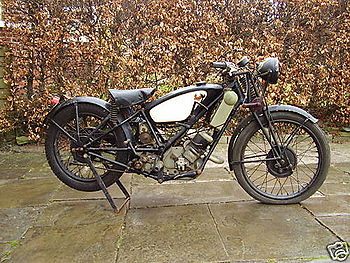Scott Squirrel
Scott built their reputation by flying in the face of convention. In the pioneer days, their delicate but never frail two-stroke twins were a delightful and effective alternative to the bicycle-framed, girder-forked, four-stroke single norm. But with the death of the founder in 1923 all that began to change. The late vintage Squirrel slid towards a conformity that would eventually lose much of the charm of the originals. At the time, it seemed an attractive answer to satisfying the demands of an increasingly conservative mass market and was a favourite machine for many competition riders.
The Squirrel name came into being in 1921, on the new 500cc sports model. It was an appropriate name for a cheeky, agile machine that was third in the Senior TT of 1922, made a fastest lap in the 1923 event and was second in 1924. At first, the Squirrel remained true to Alfred Scott's original open frame, two-speed concept. But from 1922, the company began to dabble with a three-speed design, using a conventional gearbox and clutch and the three-speed Scott Squirrel was therefore shown in 1923. In 1926, the racing version's gearbox was much improved. But more importantly, the frame and forks were completely revamped. The frame was made of heavier tubing and the fork was extensively braced.
There was a top bracing tube and the tank filled the open frame as on racing machines. The resulting machine had a more conventional appearance but had gained around one-third in weight. This model was the basis of the roadster Flying Squirrel models that followed. The 500cc machine that appeared at the 1926 Earls Court Show was identical, along with a 600cc option. There was a considerable increase in price, making them around twice the price of a sporty four-stroke.
The year 1928 saw Scott's last place in a Senior TT, a third and towards the end of the season the factory put a replica on sale. It would become one of the best loved models. As part of a cost-cutting exercise for 1929, which saw the Squirrel drop in price, they also launched a more basic Tourer at under £70.
By 1931 Scott's financial straight jacket and the mounting recession had the firm in great difficulties. There was no entry at the TT, not the annual motorcycle show. There were detail modifications to the range each year but the most significant effort were reserved for a prototype three-cylinder two-stroke. Although this was proudly shown in 1934, Scott lacked resources to exploit the design.
The original Scott went out of production during the war and never really recovered after it. In 1950, the firm was sold to Matt Holder's Aerco company, based in Birmingham. Holder continued to sell bikes from the assets acquired but it was not until 1956 that a new bike was built. The Birmingham Scotts had a conventional swinging arm frame and a 600cc version of the Scott engine.
Scott Squirrel Stats[edit | edit source]
- Years in production - 1926-40
- Engine - Parallel twin-cylinder water-cooled two-stroke
- Capacity - 596cc
- Carburetor - Binks
- Gearbox - three-speed with hand-change
- Wheelbase - 55.5in
- Weight - 325lb
- Top speed - 70mph
